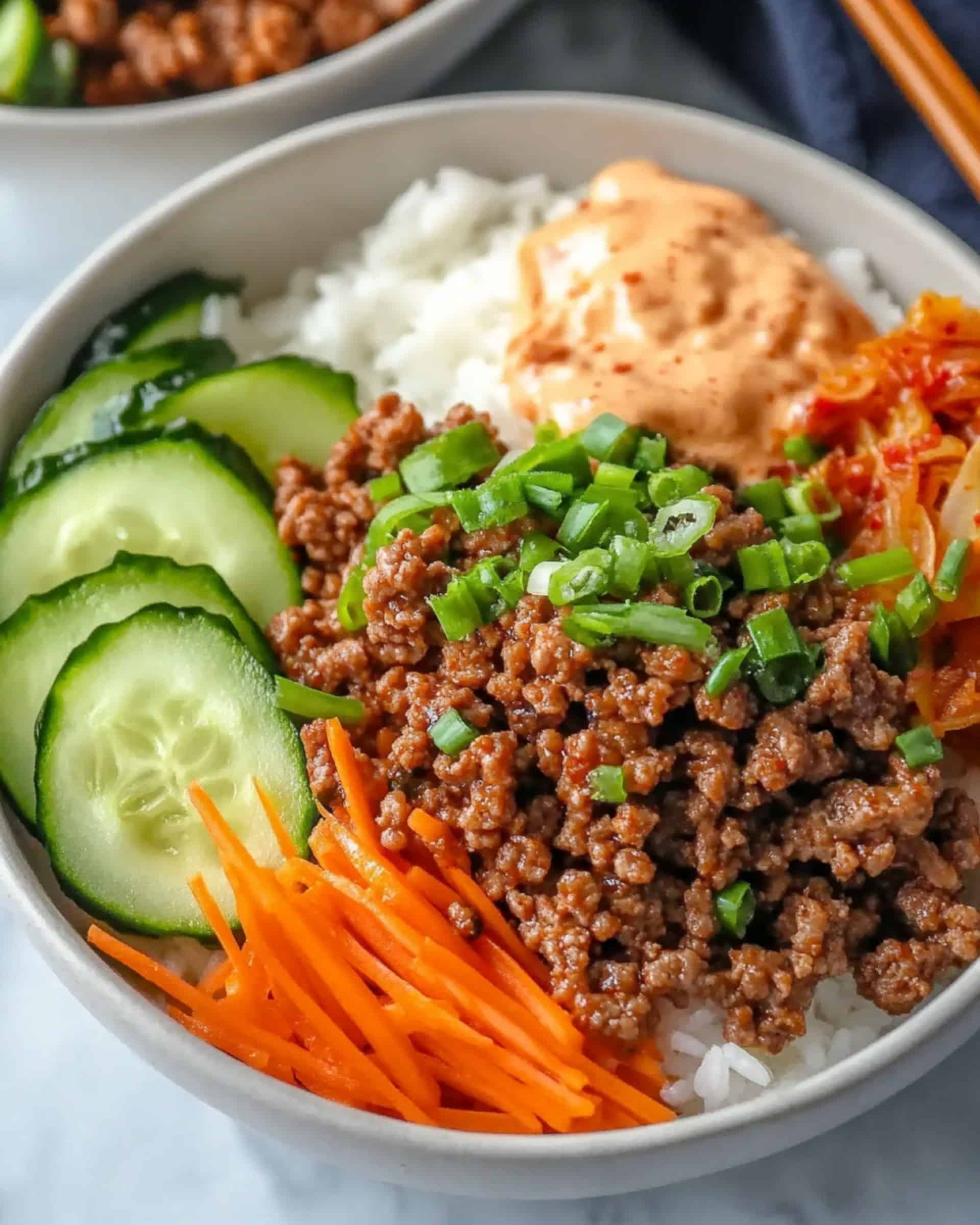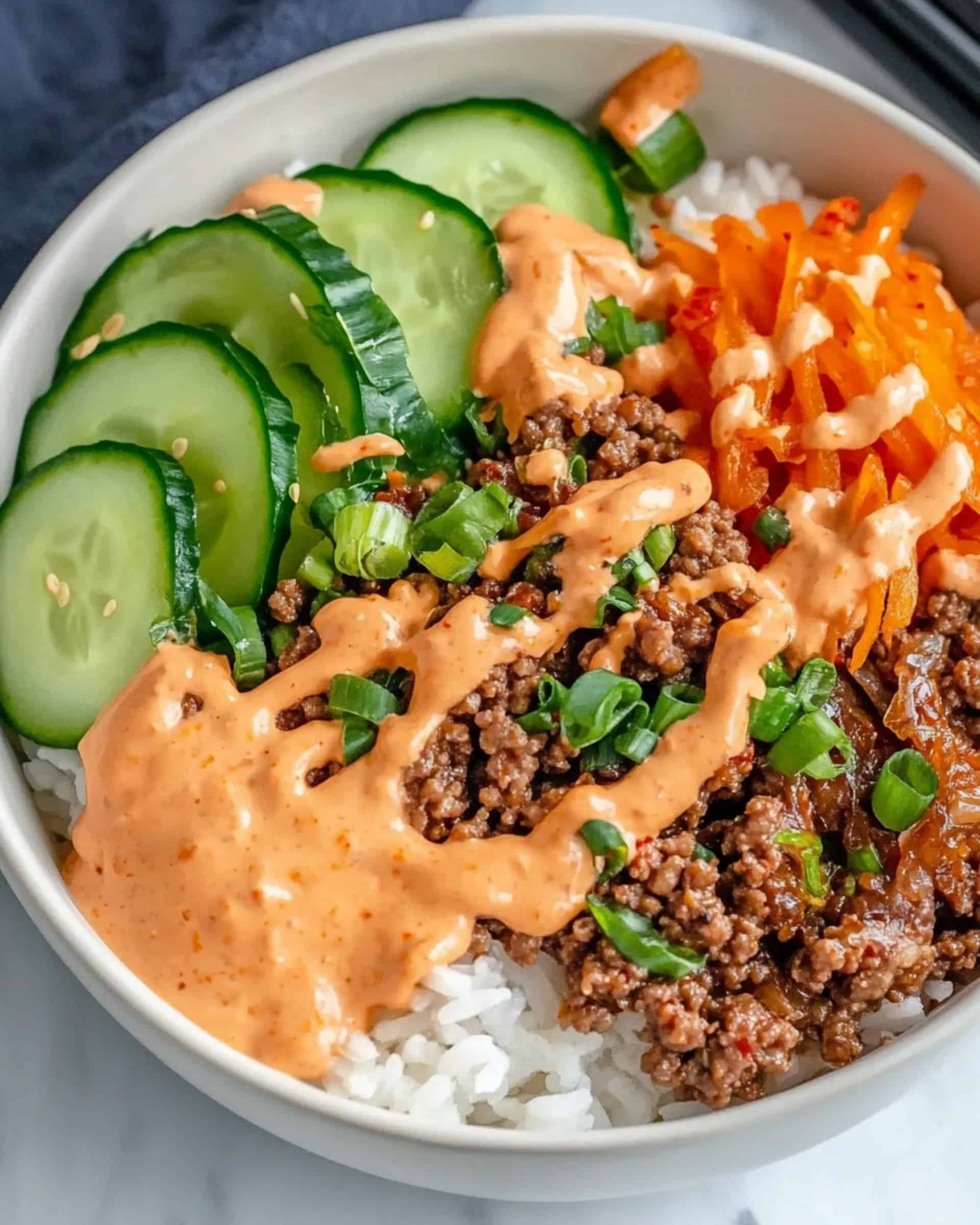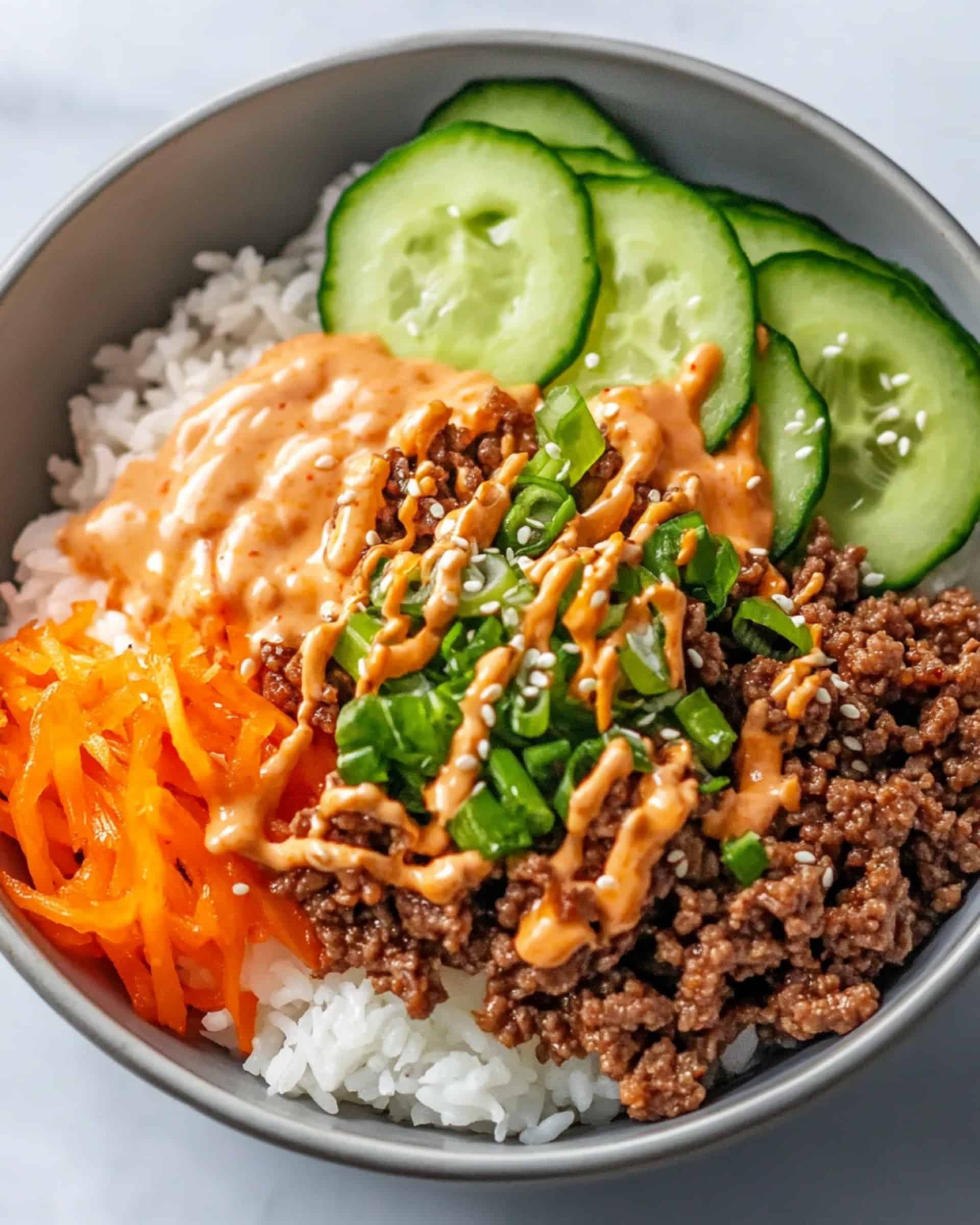This Korean Beef Rice Bowl is a flavor explosion that takes just 20 minutes from start to finish! Tender beef coated in a sweet-savory-spicy sauce sits atop fluffy jasmine rice, complemented by crisp vegetables and a creamy gochujang mayo drizzle. It’s the perfect solution for busy weeknights when you crave something delicious but don’t have hours to spend in the kitchen.
Why You’ll Love This Recipe
- Quick and Satisfying: This entire meal comes together in just 20 minutes! Perfect for those nights when you want a homemade dinner but don’t have the energy for complicated cooking.
- Balanced Flavors: The combination of sweet, savory, and spicy elements creates a perfectly balanced dish that hits all the right notes.
- Customizable Heat Level: You can easily adjust the spiciness to suit everyone at your table, making it family-friendly while still maintaining authentic Korean flavors.
- Complete Meal: With protein, carbs, and vegetables all in one bowl, you don’t need to worry about making side dishes – it’s a complete meal in itself!
Ingredients You’ll Need
- Ground Beef: The star protein that cooks quickly and soaks up all the delicious flavors of the sauce. Choose lean ground beef for less fat but still plenty of flavor.
- Gochujang: This Korean chili paste brings the signature flavor to this dish. It offers a beautiful balance of sweet, savory, and spicy that’s truly unique.
- Soy Sauce: Provides that umami depth that forms the foundation of the sauce. It helps tenderize the beef while adding saltiness.
- Brown Sugar: Balances the salty and spicy elements with necessary sweetness. It also helps create that beautiful glaze on the beef.
- Sesame Oil: Just a small amount adds tremendous nutty flavor that’s distinctly Asian. This is not an ingredient to skip!
- Garlic and Ginger: These aromatic ingredients add freshness and depth. Always use fresh if possible – the flavor difference is remarkable.
- Rice Vinegar: Provides a subtle tang that balances the richness of the beef and sweetness of the sauce.
- Sesame Seeds: Adds texture and visual appeal, plus a nutty flavor that complements the sesame oil.
- Jasmine Rice: The perfect base for soaking up all the wonderful sauce. Its fragrant nature complements the Korean flavors beautifully.
- Fresh Vegetables: Cucumber and carrots add refreshing crunch and color contrast. They help cut through the richness of the beef.
- Kimchi: This fermented side dish adds complexity, probiotics, and an authentic Korean touch. The tanginess works wonderfully with the rich beef.
- Mayonnaise: Creates a creamy drizzle that ties everything together and adds richness.
Variations
Protein Options: Not a beef fan? This recipe works beautifully with ground chicken, turkey, or pork. For a vegetarian version, try crumbled firm tofu or tempeh.
Veggie Additions: Feel free to add bell peppers, mushrooms, or spinach to increase the vegetable content. Blanched bean sprouts also make a wonderful topping.
Grain Alternatives: While jasmine rice is traditional, brown rice works well for a higher fiber option. For a low-carb version, serve over cauliflower rice.
Heat Level: Customize the spice level by adjusting the gochujang. If you can’t find gochujang, substitute with sriracha mixed with a bit of miso paste for a similar flavor profile.
How to Make Korean Beef Rice Bowls
Step 1: Prepare the Stir-Fry Sauce
Combine the freshly grated garlic, ginger, soy sauce, brown sugar, sesame oil, gochujang, rice vinegar, and sesame seeds in a small bowl. Whisk until well blended and the sugar dissolves. This sauce is the flavor foundation of your dish, so take a moment to taste and adjust to your preference.
Step 2: Cook the Beef
Heat olive oil in a large frying pan over medium-high heat. Add your ground beef and cook until nicely browned, breaking it into smaller pieces as it cooks. This usually takes about 5-7 minutes. Once browned, pour in your prepared stir-fry sauce and stir well to coat every bit of beef. Let it simmer for 2-3 minutes until the sauce thickens slightly and glazes the meat. Turn off the heat and stir in most of the sliced spring onions, saving some for garnish.
Step 3: Make the Gochujang Mayo
In a small bowl, combine mayonnaise, gochujang, sesame oil, and rice vinegar. Whisk until smooth and well incorporated. This creamy, slightly spicy sauce adds a wonderful contrast to the dish.
Step 4: Assemble Your Bowls
Divide the cooked jasmine rice among four bowls, creating a base for your toppings. Spoon the Korean beef mixture over the rice. Arrange kimchi, julienned carrots, and cucumber slices around the beef. Drizzle the gochujang mayo over everything, then sprinkle with reserved spring onions and extra sesame seeds.
Pro Tips for Making the Recipe
- Don’t Overcook the Beef: Cook the ground beef just until it’s no longer pink for the most tender result.
- Prep Ingredients First: Have all your ingredients ready before you start cooking since this recipe moves quickly once you begin.
- Balance Is Key: Taste your sauce before adding to the beef and adjust sweetness, saltiness, or heat as needed.
- Rice Preparation: Start your rice first, as it will be cooking while you prepare everything else.
- Control the Sauce Consistency: If you prefer a thicker sauce, let it simmer a bit longer. For a thinner sauce, add a tablespoon of water or broth.
How to Serve

Perfect Pairings
This Korean beef bowl is delicious on its own, but you can enhance the meal with simple sides like:
- A light miso soup
- Korean pickled radish (danmuji)
- Blanched and seasoned spinach (sigeumchi namul)
Serving Suggestions
For a DIY family dinner, set up a “bowl bar” with the beef, rice, and all toppings in separate containers, allowing everyone to build their own bowl exactly how they like it.
Beverage Pairings
This dish pairs wonderfully with:
- Cold Korean barley tea (boricha)
- A light lager beer
- Sparkling water with a squeeze of lime
Make Ahead and Storage
Storing Leftovers
Store the components separately in airtight containers in the refrigerator for up to 3 days. Keep the beef mixture, rice, fresh vegetables, and sauce in separate containers for best results.
Freezing
The beef mixture freezes well for up to 2 months. Thaw overnight in the refrigerator before reheating. The fresh toppings and rice are best made fresh rather than frozen.
Reheating
Gently reheat the beef in a skillet over medium heat or in the microwave until just warmed through. Add a tablespoon of water if it seems dry. Refresh with a sprinkle of sliced green onions before serving.
FAQs
What is gochujang and can I substitute it?
Gochujang is a Korean fermented chili paste that adds a unique sweet-spicy flavor. If unavailable, you can substitute with a mixture of 1 part sriracha, 1 part miso paste, and a pinch of sugar. The flavor won’t be identical, but it’ll provide a similar sweet-spicy element.
Can I make this recipe less spicy for my family?
Absolutely! Start with just 1 teaspoon of gochujang in both the beef sauce and mayo drizzle, then adjust to taste. You can also substitute tomato paste for gochujang in the beef sauce and omit it from the mayo drizzle altogether for a very mild version.
What can I use instead of ground beef?
Ground chicken, turkey, or pork work beautifully in this recipe. For a vegetarian version, use crumbled firm tofu or tempeh, though you might want to increase the seasonings slightly as these proteins don’t have the natural richness of beef.
Can I prepare components of this meal in advance?
Yes! You can prepare the beef mixture and gochujang mayo up to 3 days ahead and store in the refrigerator. The vegetables can be prepped 1-2 days in advance. Just assemble everything fresh when you’re ready to eat.
Final Thoughts
This Korean Beef Rice Bowl brings restaurant-quality flavors to your kitchen table in just 20 minutes. The combination of savory-sweet beef, fresh vegetables, tangy kimchi, and that irresistible gochujang mayo creates a balanced meal that satisfies on every level. It’s become my go-to recipe for busy weeknights when I want something impressive without the fuss. Give it a try – I’m confident it will become a regular in your meal rotation too!
Print
Korean Beef Rice Bowls Recipe
- Prep Time: 5 minutes
- Cook Time: 15 minutes
- Total Time: 20 minutes
- Yield: 4 servings 1x
- Category: Main Course
- Method: Stovetop
- Cuisine: Korean-inspired
Description
A flavorful and fuss-free Korean-inspired dish packed with savory minced beef, colorful veggies, and a spicy mayo drizzle, all served atop fluffy jasmine rice. Bursting with umami flavors, this dish is quick to make and perfect for a hearty lunch or dinner. Customize the spice level to suit your taste with gochujang, and enjoy a satisfying, balanced bowl that’s as healthy as it is delicious!
Ingredients
Stir-Fry Sauce
- 1 tsp freshly grated garlic
- 1 tsp freshly grated ginger
- 3 tbsp all-purpose soy sauce
- 2 tbsp brown sugar
- 1 tbsp sesame oil
- 1 tbsp gochujang (adjust for spice preference, see Note 1 for substitutions)
- 1 tsp rice vinegar
- 1 tbsp sesame seeds, plus extra to garnish
For the Stir-Fry
- 2 tbsp extra-virgin olive oil or neutral oil
- 500 g (1 lb 2 oz) minced (ground) beef
- 2 spring onions (scallions), finely sliced (1 tbsp reserved for garnish)
For the Mayo Drizzle
- 3 tbsp whole-egg mayonnaise
- 1 tsp gochujang
- 1/2 tsp sesame oil
- 1/2 tsp rice vinegar
To Serve
- 2 cups (370 g) cooked jasmine rice
- 1 cup (240 g) kimchi
- 1 carrot, julienned
- 1 Lebanese (short) cucumber, sliced into half moons
Instructions
- Make the Stir-Fry Sauce
In a small bowl, whisk together freshly grated garlic, ginger, soy sauce, brown sugar, sesame oil, gochujang, rice vinegar, and sesame seeds until fully combined. Set this mixture aside for later use. - Cook the Beef
Heat the olive oil (or neutral oil) in a large frying pan over medium–high heat. Add the minced beef and cook until it is browned, breaking it up into smaller pieces as it cooks. Once the beef is evenly browned, pour in the prepared stir-fry sauce and stir to coat. Allow the mixture to simmer for 2–3 minutes, letting the sauce thicken slightly. Turn off the heat and mix in the finely sliced spring onions, reserving a tablespoon for garnish. - Prepare the Mayo Drizzle
In a small bowl, whisk together the mayonnaise, gochujang, sesame oil, and rice vinegar until smooth and creamy. Set aside for serving. - Assemble the Bowls
Divide the cooked jasmine rice evenly among four bowls. Top each bowl with the prepared Korean beef mixture, followed by generous servings of kimchi, julienned carrot, and sliced cucumber. Drizzle the gochujang mayo over the top, and garnish with extra sesame seeds and spring onions. Serve immediately for the best taste and texture.
Notes
- Note 1: If using gochujang for the first time, start with 1 teaspoon and adjust to taste. For a non-spicy version, substitute gochujang with tomato paste and omit it from the mayo drizzle.
- Make Ahead:
- Prepare the beef mixture up to 3 days in advance and store it in an airtight container in the refrigerator. Reheat gently on the stovetop or in the microwave before using.
- Gochujang mayo can be mixed up to 3 days ahead and kept in a covered container in the fridge.
- Slice cucumber and julienne carrot up to 2 days in advance and store in airtight containers.
- Leftovers: Keep the toppings separate from the beef mixture when storing. Place leftovers in airtight containers in the fridge for up to 3 days. Reheat beef gently before serving. Not suitable for freezing.
Nutrition
- Serving Size: 1 bowl
- Calories: 525
- Sugar: 12g
- Sodium: 950mg
- Fat: 26g
- Saturated Fat: 8g
- Unsaturated Fat: 16g
- Trans Fat: 0g
- Carbohydrates: 45g
- Fiber: 3g
- Protein: 26g
- Cholesterol: 75mg



